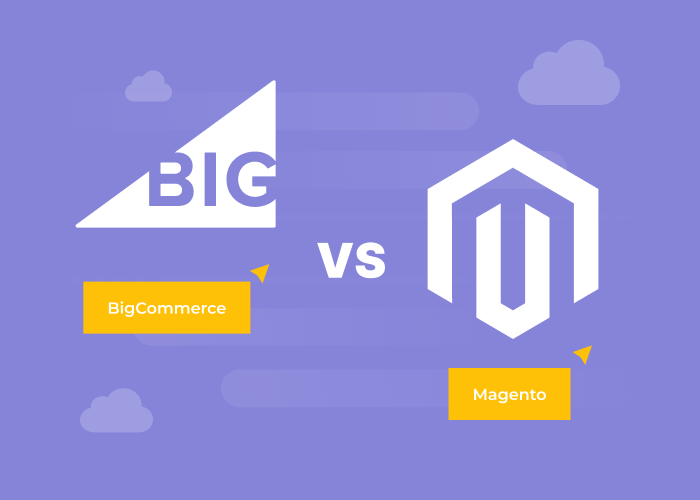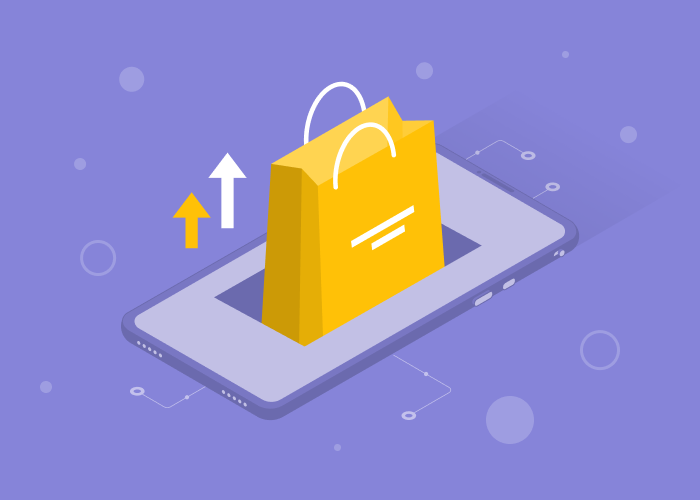Content
11 Best Open Source eCommerce Platforms for 2023

Online presence is vital if you want to stay competitive in today's world. This is true both for small and medium-sized companies. However, to launch online successfully, you need a sound strategy encompassing a great deal of business aspects. In particular, you can partner up with an ecommerce management services provider who will drive the development of your ecommerce solution and choose the right platform that will meet your business needs. Today, we will help you with the ecommerce platform choice. We’ve reviewed the top 11 open source ecommerce platforms you can choose from, including the open-source ecommerce platforms comparison. Using this information, you will get a clear picture of modern eCommerce technologies.
Lets talk about itHave a project in mind?
To begin with, you should decide whether you need an open source eCommerce solution or another type of platform. Before choosing any platform, you should first answer these questions:
- Does my online shop have custom features?
- Do I have enough budget to hire a team of eCommerce developers?
- Is the custom web design essential for my business?
If your answer is “Yes” to all those questions, we can move further, because your option is an open source eСommerce website builder.
Also read: How to Launch a Successful e-Commerce Website: The Ultimate Checklist
So, What Is an Ecommerce Platform?
An ecommerce platform is a software application which allows online businesses managing their website, marketing, sales and operations. It has a huge impact on the profitability and stability of your business. Ecommerce platforms provide the unification of main business processes, due to which businesses get complete visibility across their company and at the end meet their customers' expectations. Due to individual ecommerce platform development you will be able to get a custom e-commerce platform with intuitive UI that suits changing business needs.
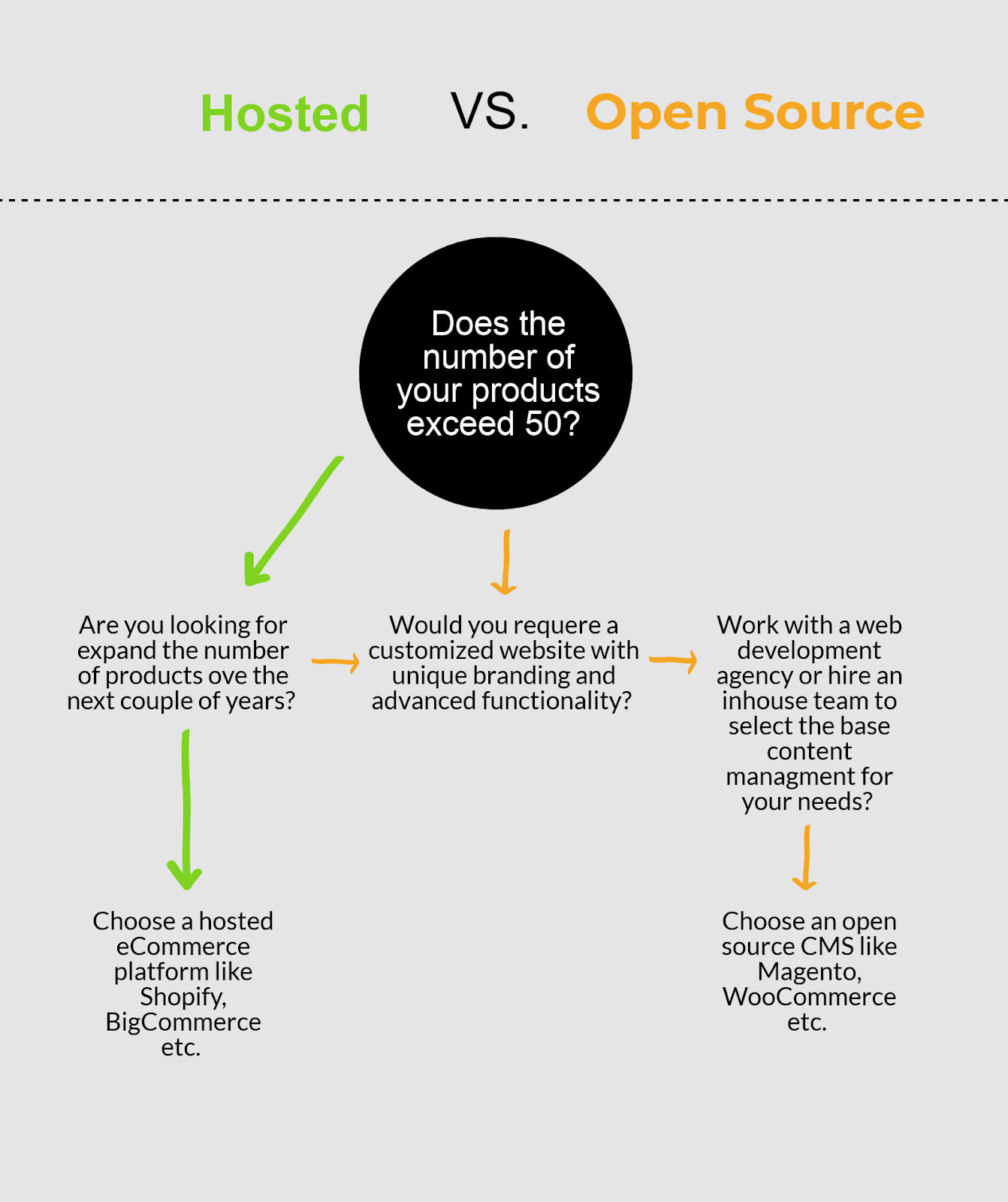
The Top Ecommerce Platforms: What is the best eCommerce platform 2022?
When you are choosing the best eCommerce platform for online store, you have multiple free and paid choices. At this point, it shouldn’t be surprising that SaaS- ecommerce platforms will cost much more. That’s because they manage your web hosting, provide support and updates.
On the other hand, Open Source solutions are of course cheaper — a far cry from the SaaS-based models.
Today there are many types of open source eСommerce software for every business. Their main benefits are:
- Most of them are free.
- Platforms give the business a customizability opportunity.
- You can scale your online shop anytime.
- Most platforms with open source have developed community support.
In this article, we are going to share the open source eСommerce software comparison.
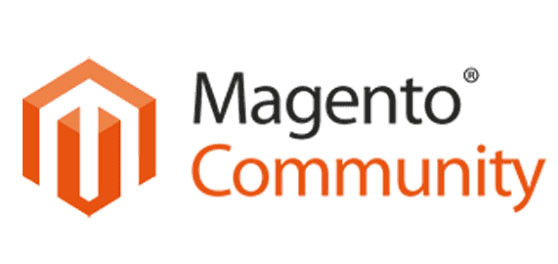
1. Magento Community Edition
Many online retailers think that Magneto is the best open source eСommerce platform. Why? Because currently, it holds about 26% of the e-commerce software market. That fact makes Magento an industry leader. It’s the best ecommerce platform for large business handling a large amount of traffic and looking for great technical, installation and troubleshooting support. However, it does not suit all companies. There are different plans on this platform. For instance, Magento Enterprise Edition, mostly used by big companies, costs about $22,000 a year.
Nevertheless, Magento also has a solution for small and medium companies. With a Community Edition, online retailers can enjoy loads of features for free.
The most notable features are of using different currencies and supporting languages, managing multiple stores, and customs modules.
Magento is also a multi-store ecommerce platform.
Another benefit of using Magento is a wide range of plugins and add-ons. That way, this platform provides users with flexibility and infinite scalability.
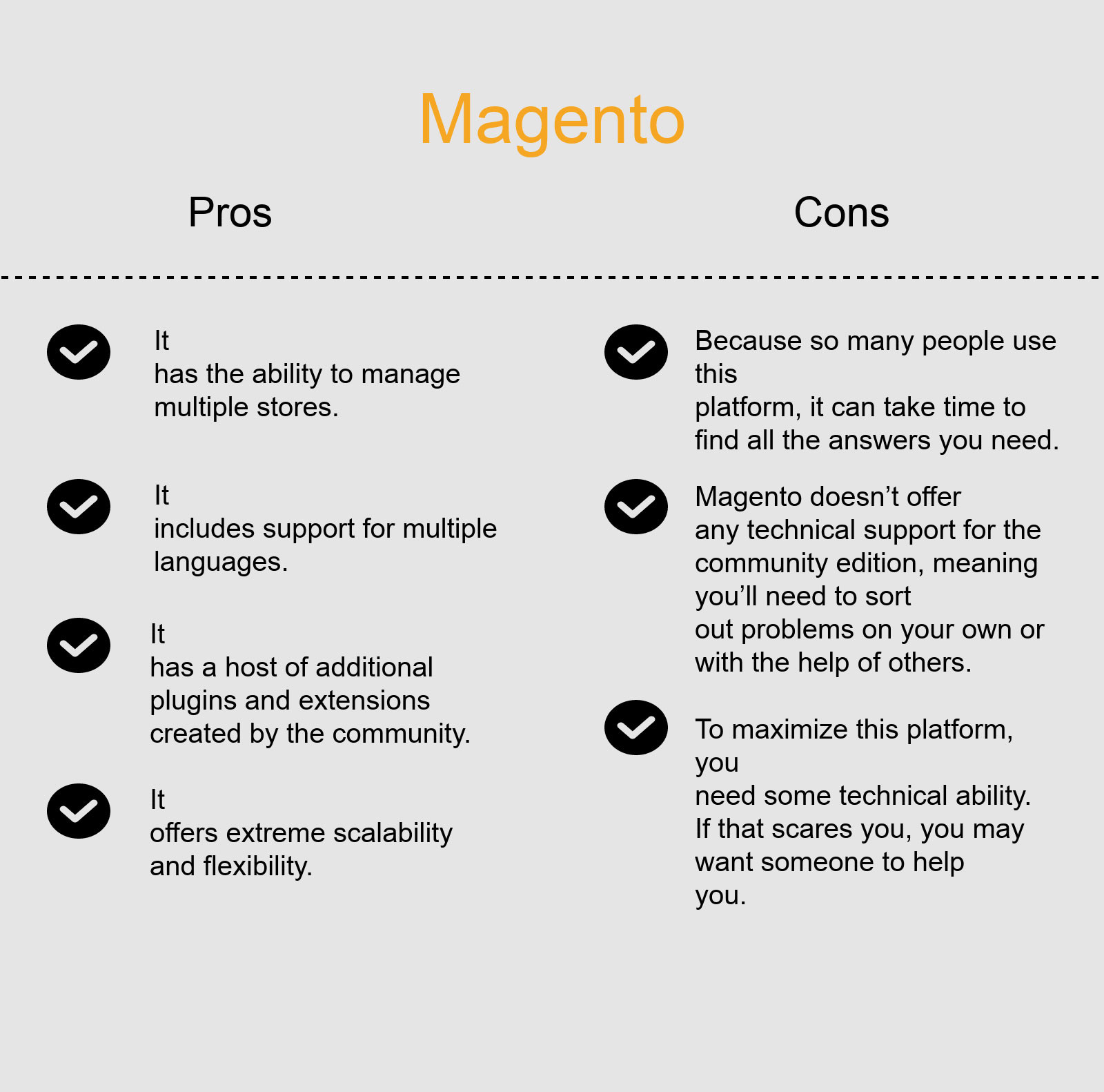
Also read: How to Hire the Best Magento Developers
At the same time, Magento has its drawbacks. First, since the community is very big, it could be a challenge to find the answer to your need in the forums.
In most cases, even if an online retailer has knowledge in coding, he would rather hire an e-commerce agency to make all the necessary changes.
Also read: Magento vs Shopify: ECommerce Platforms Comparison
You should not pay for Magento Community Edition, but if you want some custom features or a beautiful design, you should buy extensions, plugins, and templates at the marketplace.

2. Shopware
Shopware is one of the most popular ecommerce platforms nowadays. Founded in 2000, it became a perfect solution for shops of any size. The platform supports multiple storefronts, multiple languages and currencies right out of the box.
Shopware's architecture is modern and tough. Templates, plugins, and extensions can be added according to a well-defined development process and can be easily integrated into the admin environment.
Among the main advantages of Shopware are its symbiosis of technology and design, simple setup and administration of the Shopware shop, on-premise and cloud-based solutions, high flexibility and marketing orientation. Moreover, there is a Shopware community with discussions of almost any relevant topic.
Lets talk about itHave a project in mind?
On the other hand, the disadvantages of Shopware are relatively high costs (but the exception is the free open-source tariff), comparably small number of plug-ins and additional costs for social media functions.
One more point to consider is its focus on the German market. The expertise and specialization in the German e-commerce market are, in many cases, an advantage, however, this is not always the case.
Also read: Why use Shopware for your online business?
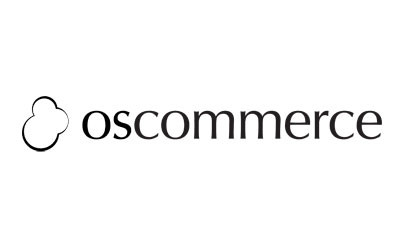
3. osCommerce
If your business needs a platform simple in maintenance, osCommerce is a perfect choice. This “old reliable” solution is still popular among online retailers. To provide your online shop visitors with custom designs and functionality, you can use 7,000 extensions created by osCommerce developers.
osCommerce platform has developed community that includes over 26,000 online retailers. In case of any problems with your website, you can use the support network.
If you think that osCommerce suits you the best, you should know about its disadvantages. The platform is quite old and not as powerful as modern e-commerce solutions. In this case, online shop scaling could be a challenge.

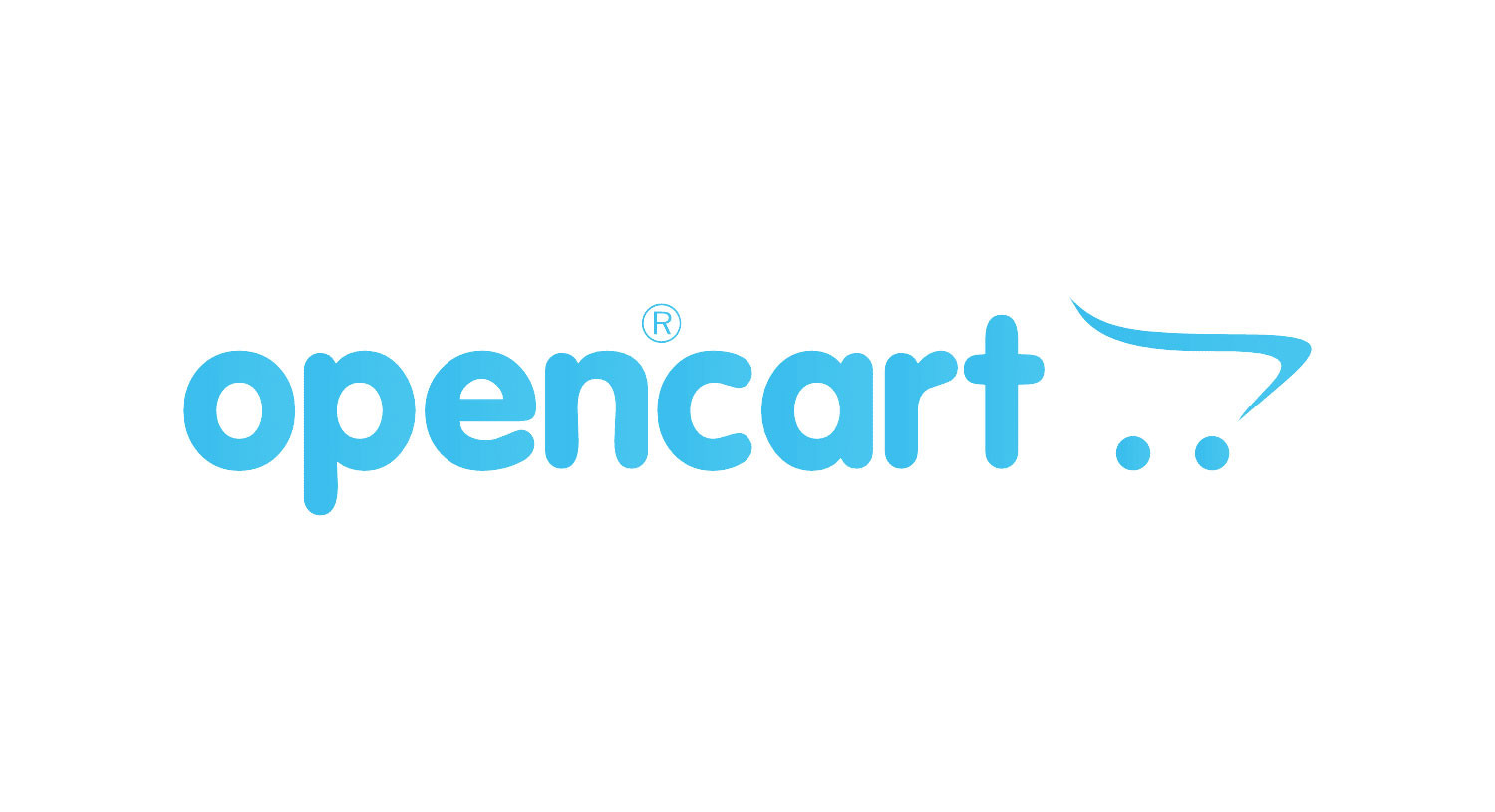
4. OpenCart
OpenCart is one of the most popular php ecommerce platforms. It suits perfectly to online retailers, who have a small business and are not technological persons. This solution is easy to set up. OpenCart has basic e-commerce functions that might be helpful to start your first online shop. However, this can also be a disadvantage if you plan to scale your business and launch marketing activities.
Meanwhile, in the first stages of setting up an OpenCart website, you need to hire an e-commerce agency to help you with some code. To add more functions and to make your online shop more flexible, you can use tons of different plugins.
OpenCart weak point is that some plugins do not always work together and have poor compatibility. Another drawback is updated that may never come. If you are not scared to put your business at the mercy of software developers, you can use this solution.
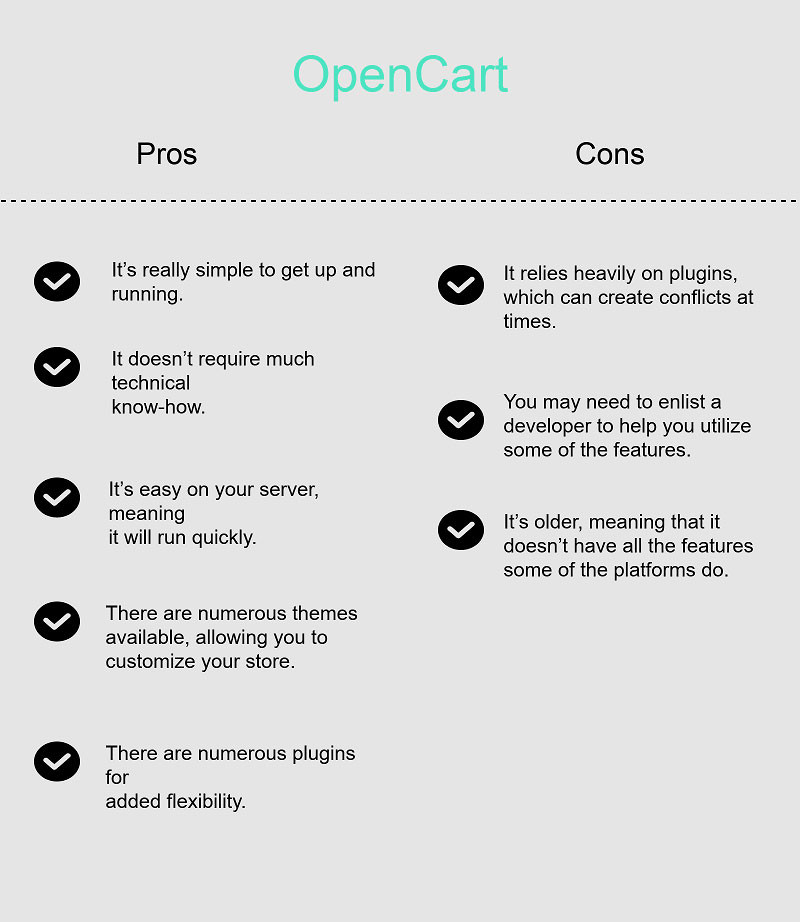

5. Spree Commerce
This online store platform was developed on Ruby on Rails. With many online business owners, Spree Commerce platform is growing very fast. Why is it so popular? Users say this platform is easy to learn and has rich functionality.
The platform also provides many ready-made extensions so users do not need to use a third party for improving feature list.
Spree Commerce has advantages of scalability and flexibility. Online retailers can add any custom feature to their website. Such advantages make this e-commerce solution one of the top eCommerce platforms in 2022.
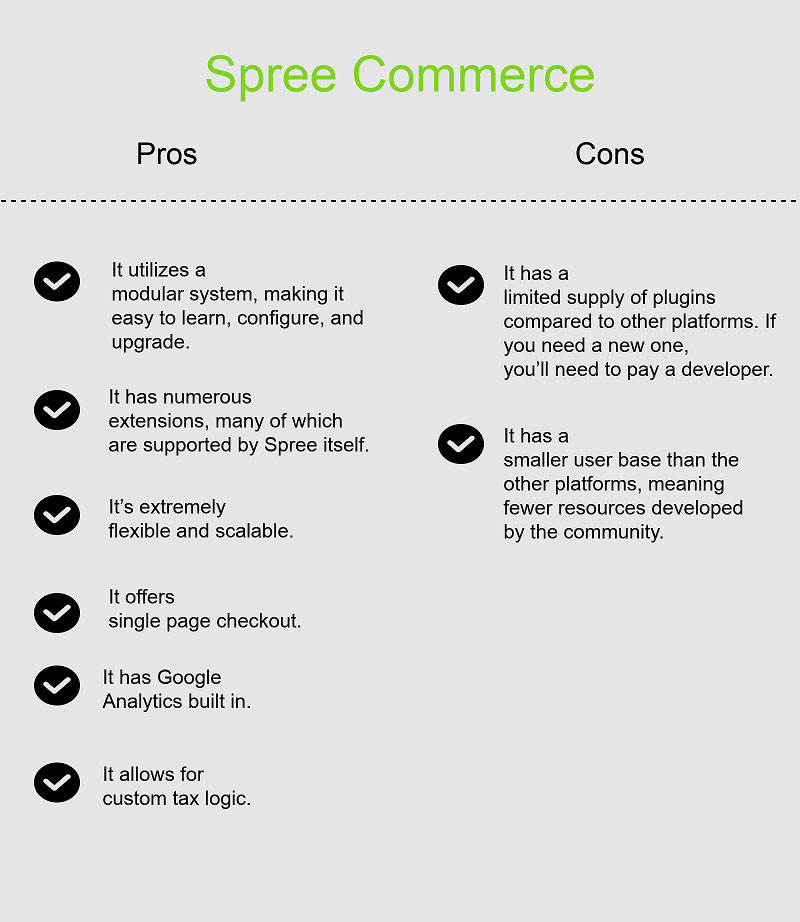
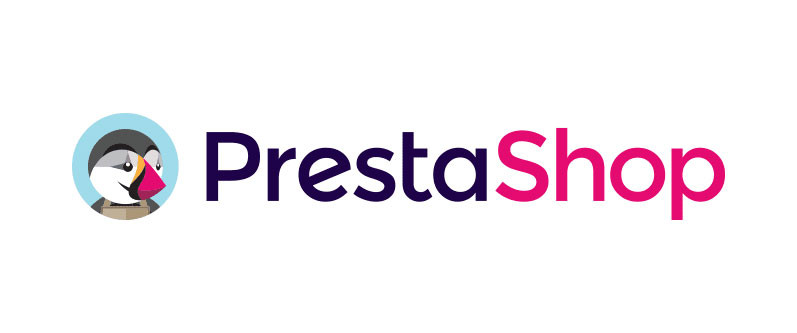
6. PrestaShop
This best open source e-commerce software is very popular among online retailers. For this reason, we decided to add PrestaShop to this open source eCommerce platforms reviews and see PrestaShop pros and cons.
PrestaShop has the intuitive admin panel. Users can easily install an e-commerce website. With this platform, you can determine the level of technical control since there are both self-hosted and fully hosted options. Moreover, both of them are free.
With over 250,000 stores using the ecommerce platform, PrestaShop is very popular due to its ease of use. It definitely can be considered as the easiest ecommerce platform.
When considering the best CMS for e-commerce, pay attention that PrestaShop also has its disadvantages. There are limited options for website customization. If you are looking for a platform that allows your business to create a bright design and many graphic elements, look for something else.
To customize the design on the PrestaShop website, you can buy extra themes.
Nevertheless, PrestaShop also has its disadvantages. There are limited options for website customization. If you are looking for a platform that allows your business to create the bright design and many graphic elements, look for something else.
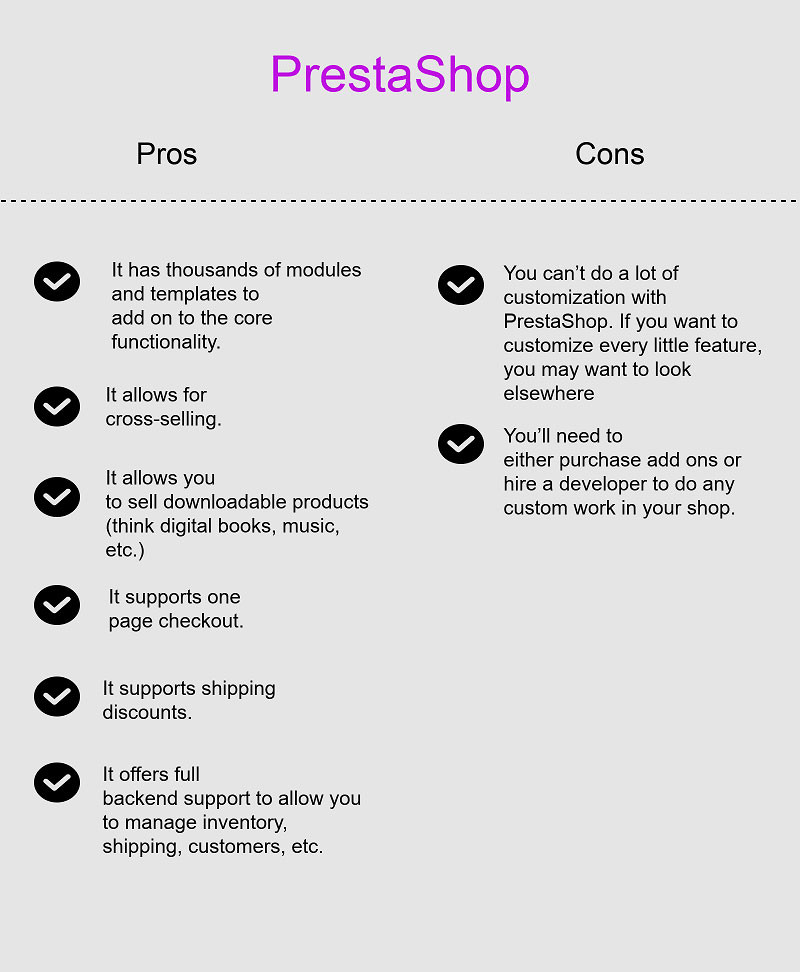

7. Zen Cart
Zen Cart platform has many users and a great supporting community. If you need a platform with developed product management features, this one will fit your business. This open source website builder has over 150,000 members in the support community.
What advantage will you get with Zen Cart? The main advantage as we said before, is great product management. Users are free to create sales, specials and control inventory.
However, pay attention that adding too many products may slow down the system. If your business offers many products, you should consider another open source eCommerce software.
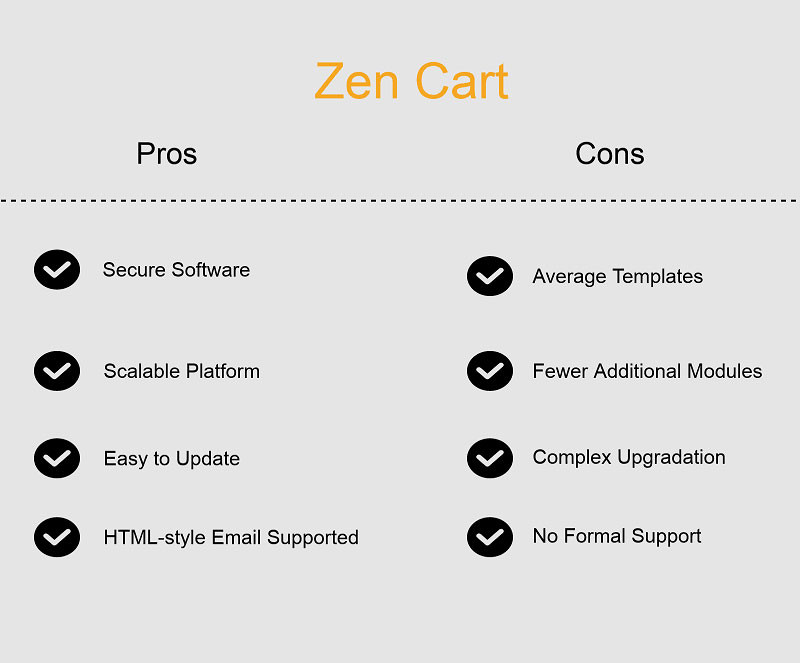
When choosing Zen Cart as an open source e-commerce platform for your online retail business, you should be aware that this platform has a kind of unattractive design by default. To make an e-commerce website on Zen Cart attractive, you will need some help from developers. You can also buy templates to make your storefront look more attractive.

8. WooCommerce
If you're into WordPress and want to start online business, we can offer you several options. However, in this part, we are going to tell you about the most popular WordPress plugin WooCommerce. This leading open source solution for e-commerce also has a great user community.
One of its benefits is that you can set up and manage your online shop without any technical knowledge so WooCommerce is considered the best ecommerce platform for startups. User-friendly admin panel made WooCommerce very popular among many retailers.
Also read: How to Build an E-commerce Website Using WordPress
This platform is mobile friendly. With this feature, your online shop visitors can make orders from their mobile devices or tablets.
As a result, you increase your sales. Moreover, one of the add-ons even allows you to create a mobile app with your products.
Take into account that WooCommerce works only with WordPress websites, which is not suitable for some types of businesses.
Nevertheless, if you are familiar with WordPress admin panel, WooCommerce will be a great option for your business. To get custom features out of this open source e-commerce solution, online retailers should pay for extensions and templates.
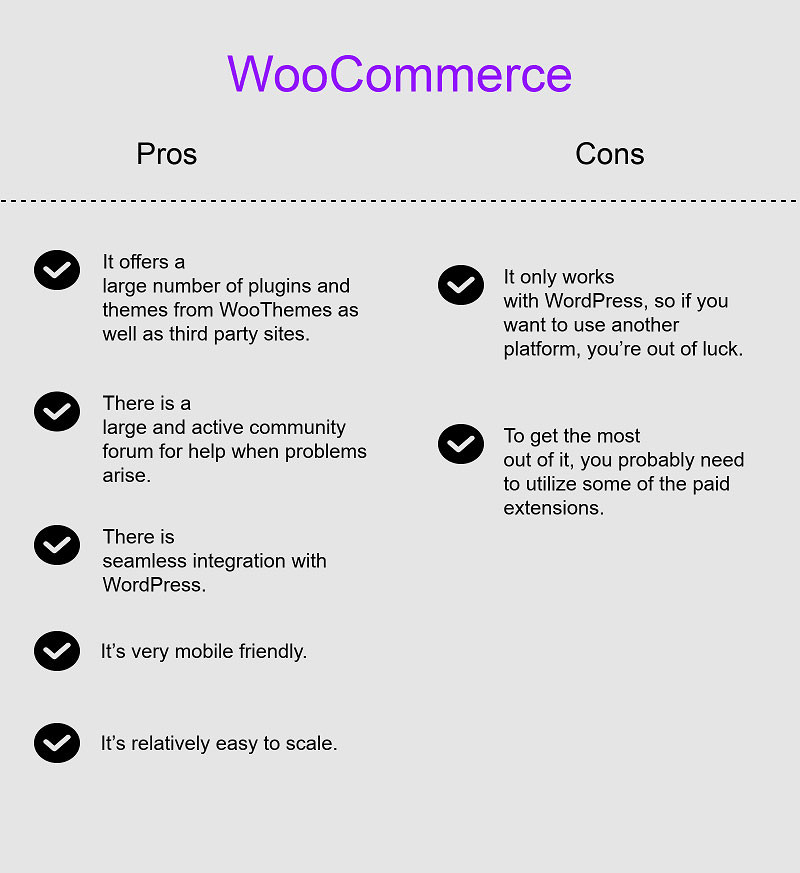

9. JigoShop
If you want to compare open source ecommerce platforms, take into account that JigoShop is one more option for WordPress fans. Like WooCommerce, this solution is easy to set up. If you want to make your online shop effective and convenient, you should pay for additional themes, extensions and plugins.
The main disadvantage of Jigoshop, as for WooCommerce – you cannot link product variations with this platform. For instance, if a business sells products of different sizes and colors, the platform requires specifying a color option for every size. The process of creating so many pages may take plenty of time.
Default features of Jigoshop are very basic, but you can buy additional upgrades to satisfy your business needs.
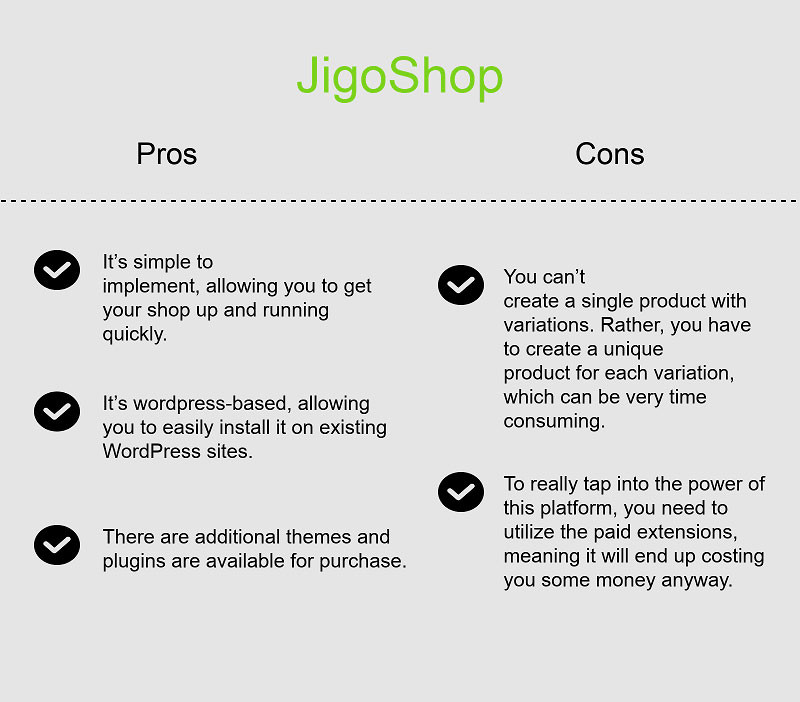

10. Drupal Commerce
If you are familiar with Drupal admin panel and looking for an e-commerce solution, Drupal Commerce may be the right choice for you. This open source e-commerce solution is not only SEO-friendly but also flexible. Do not forget about clear administrator panel and advanced payment modules, even subscription-based.
As you understand, this solution works only with Drupal websites. From the beginning, Drupal Commerce has only basic features for e-commerce. To extend a website functional, you can buy “Commerce Kickstart” package. Consisting of the most popular add-ons, it will give the new online shop a nice start.
Consider this option if you are looking for an online shop with basic features, but you plan to expand it with third-party extensions.
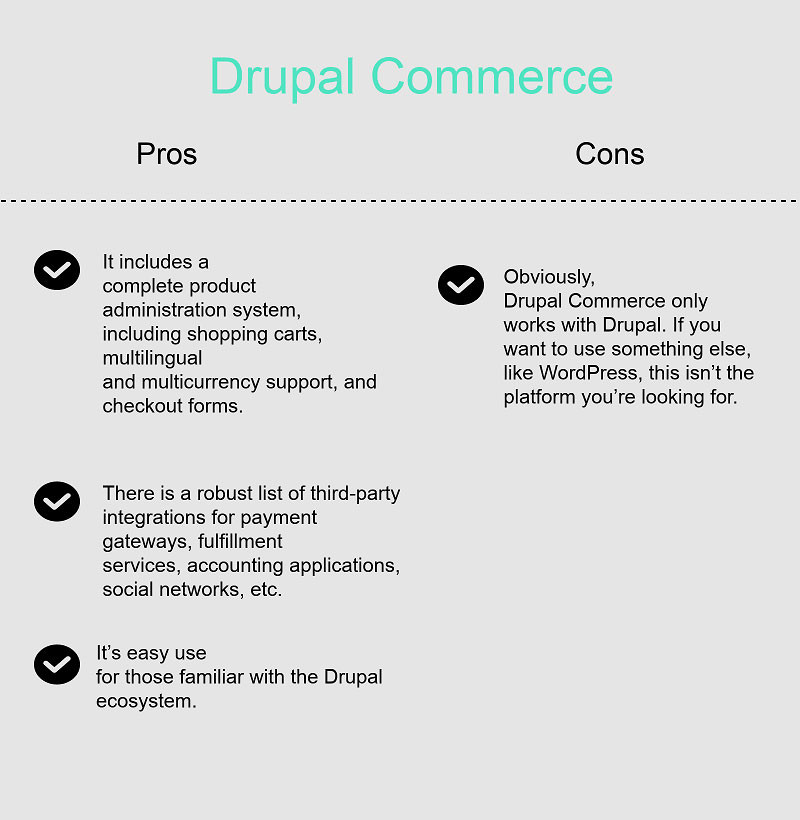
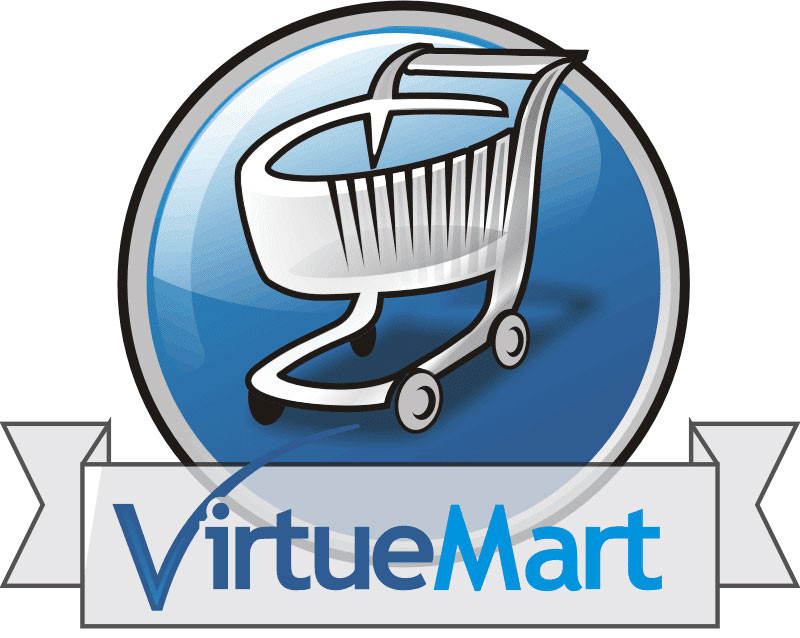
11. VirtueMart
VirtueMart is an e-commerce extension developed for websites on Joomla. It is extremely easy to set up and run an online shop with this solution. Especially if you want to sell overseas since it has multi-language capabilities.
This extension is popular for SEO friendly features, allowing online shop owners to get more traffic that is organic. So, VirtueMart is considered one of the best ecommerce platforms for SEO and it also provides users with not only inventory management but also invoicing.
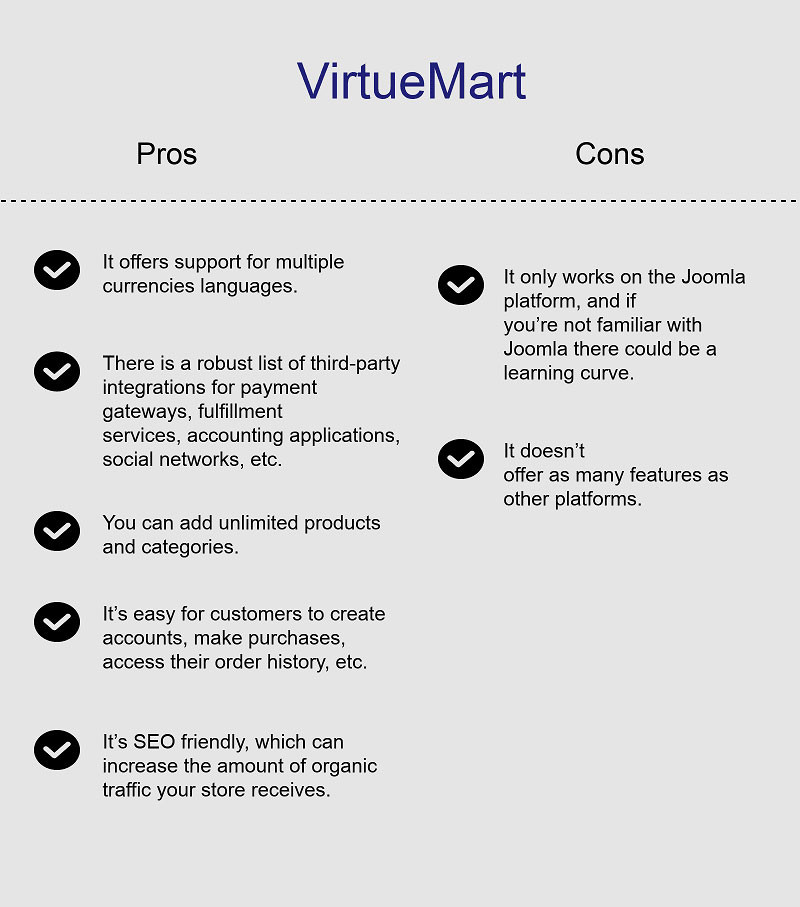
Read also: BigCommerce vs Shopify
What Is the Best Ecommerce Platform: How to choose the Best Platform for your online business?
Since you now know about the most popular open source ecommerce solutions, you can make the right decision and choose the best ecommerce platform for your business. In the table below, we share additional information about most platforms solutions and maintenance prices.
| Magento | Shopware | WooCommerce | Opencart | osCommerce | Drupal Commerce | |
| The number of online shops | 216,548 | 40,466 | 396,171 | 179,100 | 80,141 | 13,989 |
| % share of top 100,000 eCommerce websites using open source technologies | 58.2 | 0.08 | Data not valid | 6.0 | 11.1 | 7.2 |
| Number of add-ons, extensions and plugins available | High | Low | High | Medium | Medium | Medium |
| Availability of expertise for development and maintenance | Very easily available | Suitable expertise is difficult to find | Very easily available | Suitable expertise is difficult to find | Suitable expertise is difficult to find | Very easily available |
| Overall development and maintenance cost | Medium | Low | Low | High | High | Medium |
In this table, we share the comparison of pros and cons of the top e-commerce open source platforms.
| E-commerce platform | Price from (per month) | Pros | Cons |
| Shopify | $9 | Ease of use, wide range of features, extendable, mobile-friendly, great support | Advanced customization difficult, expensive, no blogging capabilities |
| BigCommerce | $29.95 | Easy to use, feature-rich, great design options, SEO and marketing, payment options, customer support | Confusing plans, expensive, lack of ownership |
| Magento | $8.99 | Feature-rich, third-party integrations, customizable, scalable, marketing-friendly, well-supported | Unsuitable for beginners, can be hard to find a developer, can be costly for the enterprise |
| WooCommerce | $3.95 | Cost-effective, easy to setup and use, feature-rich, customizable, well-supported, SEO and marketing, full ownership | Advanced customization skills required, dependent on WordPress, true costs difficult to calculate |
| Shopware | $39 | Symbiosis of technology and design, simple setup and administration of the Shopware shop, on-premise and cloud-based solutions, high flexibility and marketing orientation | Comparably small number of plug-in, additional cost for social media functions |
Conclusion
Without knowing your business size, specific and needs, it is impossible to say which platform is the best.
If you are looking for an online shop with basic features, you do not need to pay for advanced modules and extensions. Yet conversely, if you want to surprise website visitors with bright design, custom features and you have enough budget, high-performance platforms suit your business more.
We hope that our open source eCommerce software review was helpful to you.
What can Dinarys team offer your business?
Dinarys team is experienced in working with the most popular e-commerce platforms. Our developers have worked with projects on Magento and Shopware.
We offer the best solution for your e-commerce website on the basis of your budget and business needs. If you:
- already have an online shop, but have low conversion rate,
- want to improve the design,
- need to scale your business and to migrate from one platform to another
- want to expand your online shop and to develop a mobile app
- looking for custom extension development services
Just fill out the form and Dinarys team will contact you to start the new project!
Let professionals meet your challenge
Our certified specialists will find the most optimal solution for your business.

